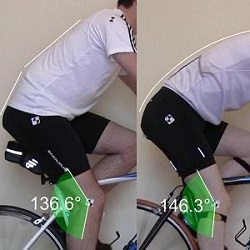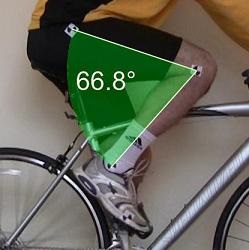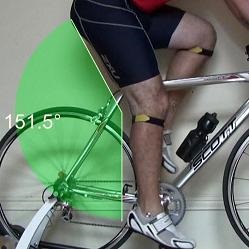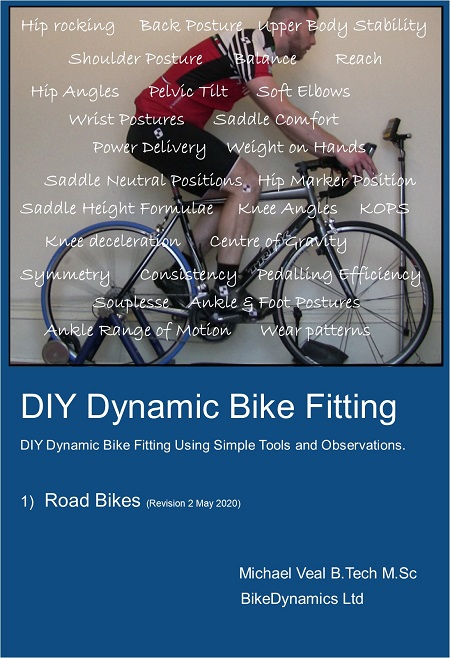Cycling Back Pain

Lower Back Pain - Pelvic Tilt
This image shows two cyclists, with the one on the right in a far lower, more aggressive position. One might imagine that of the two, he might suffer more back pain. But this was not the case, with the cyclist on the left suffering debilitating pain, very quickly into a ride. The clue is in the angle of the pelvis. The rider on the left has a noticeable hinge point in his lower back as his pelvis is reluctant to lean forwards and the lower lumbar vertebrae appear to be stiff. The rider on the right meanwhile has a smooth transition from pelvis to lumbar region and along the whole spine. In the left hand case, the saddle was too low and the rider had a very stiff right hip joint. The excessive upwards movement of the knee and lack of mobility in the hip combined to push the pelvis back.

Pelvic Rocking
This is another example of how the rider's pelvis and lower back was pushed back by the pedalling action. In this case the rearward movement was cyclical, with the hip rolling back and forth with each pedal stroke. Note the position of the right hand lower back between the top and bottom of the pedal stroke. Four factors were involved in creating this mechanism, each of which could individually cause back pain.
Saddle too low
As the foot goes over the top of the stroke, the knee comes up too high and the lower back is pushed backwards, first by one leg, then the other.

Tight Hip Joint
Lack of joint mobility will apply torsional forces to the pelvis as the knee comes up. Although not directly involved in the pedalling action, the hip adductors can often impede effective movement and benefit from regular stretching.
Crank length
The 175mm cranks fitted to this bike were too long for the 1.78m tall rider and forced the knee higher over the top of the stroke.
Foot Posture
The cyclist preferred to use toeclips, but they held the foot in the wrong position with the ball approx. 25mm behind the pedal spindle. This extreme position often creates the very toe down foot posture shown here, which again lifts the knee right up into the chest.

Saddle Too High
A saddle that is too high can cause lower back pain through a number of mechanisms. Just as overstretched hamstrings can cause tendonitis at their insertion points behind the knees, their origins on the pelvis can also become irritated. This will tend to be felt at the base of the spine and may be more apparent the following day rather than during the ride. The other more likely problems are that tight or stretched hamstrings will pull the pelvis back into a posterior tilt, or that the high saddle rocks the hips, increasing the strains in the lower back muscles and ligaments.

Leg Length Discrepancy
Many people have a leg length difference of 1-2mm and suffer no ill effects at all. The difference becomes significant from approx 2-3mm upwards, depending upon the height of the individual. The cyclist on the left had a 20mm shorter left leg as demonstrated by the much higher knee angle shown here (the left image is flipped to ease the comparison). What this means is that the saddle can be both too high and too low at the same time, with all the implications to knee and back pain outlined previously. Many people compensate for the difference by subconsciously dropping the hip of the shorter leg down and forwards. The resulting twist of the pelvis will apply additional strains to the lower back ligaments and muscles. Ideally the ankles would accommodate the difference and with some people, the heel of the shorter leg is a few mm higher, the knee angles are similar and the pelvis level. For everybody else, shimming under the cleat of the shorter leg, asymmetric cleat placement and fine saddle height tuning can often find a good compromise.
You may be interested our downloadable DIY guide.
49 Page PDF download describing all the observations, simple measurements and calculations required to do your own Dynamic Bike Fits.
Revision 2 released May 2020.
Contains updated male and female saddle height calculators and new information on male / female leg length proportions. Plus a new section to assist with saddle choice and improving comfort.
British Pound, Euro and US Dollar payments are processed by PayPal and all major credit cards are accepted. You will receive an email confirming your payment and will be automatically redirected to a page where you can download the ebook. The ebook is in PDF format so you will need to have a copy of Adobe Acrobat Reader or a similar PDF reader to read the ebook.


